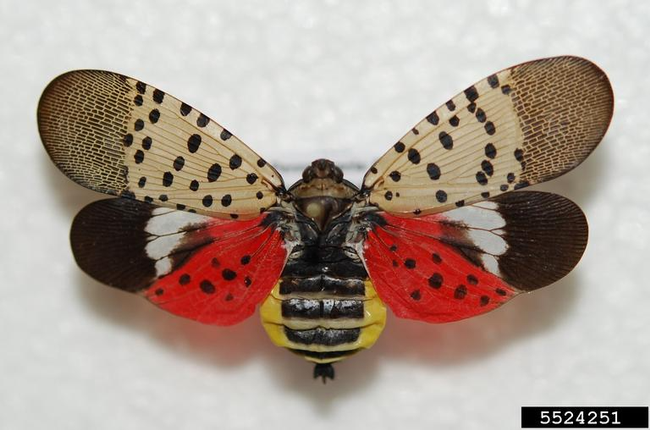
The Spotted Lanternfly (SLF) is an invasive pest that poses a great threat to California's agriculture. It was first discovered in the U.S. in Pennsylvania in 2014, and has since taken the east coast by storm, causing damage to many plant species and proving to be difficult to control. Although this pest hasn't been found in California, it is important to keep an eye out to catch an invasion early.
What does the spotted lanternfly look like?
The SLF adult is about 1 inch in length with grayish wings, black spots, and red hind wings. Egg masses are laid in the fall on the east coast and resemble splotches of mud. They are often laid on smooth surfaces like branches, rocks, or outdoor furniture. Early nymphs are very small, wingless, and black with white spots. The last nymphal stage is 1/2 inch long and red with white and black markings.
What damage does the spotted lanternfly cause?

On the east coast, the spotted lanternfly's preferred host is the invasive tree-of-heaven (Ailanthus altissima), but it will also feed heavily on grapes, maples, willows, and birch trees. SLF feeds on plant sap and excretes honeydew, which can cause sooty mold to grow on leaves and fruit. It is known to kill black walnut saplings, tree-of-heaven, and grapevines. However, for most other plants SLF is considered a plant stressor and healthy plants can usually tolerate feeding.
What can you do to help keep the spotted lanternfly out?
Spotted lanternfly is easily transported to new areas as egg masses on firewood, stone, cars, and furniture. Check vehicles and trailers when traveling to areas where SLF has been confirmed. Inspect items purchased or shipped from these areas, and don't move firewood. Familiarize yourself with the various ways that SLF egg masses may appear and report any potential sightings to the CDFA Pest Hotline: 1-800-491-1899.
If you want to learn more, visit the UC IPM Spotted Lanternfly page and consider taking the California Master Gardener Spotted Lantern Fly training module.